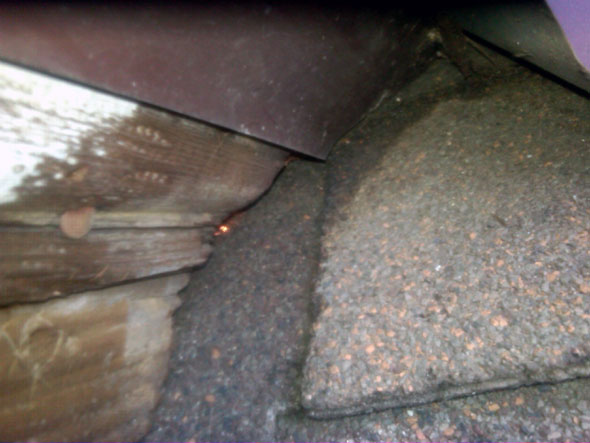There's a lot more copper mesh in there than it appears. It's there to capture the foam filler, to impede its progress so that once the mesh fills up, the foam backs up and fills the front of the gap solidly rather than simply continuing to move inward. Copper mesh is available from gardener suppliers, but in a pinch a copper pot scrubber would serve perfectly well.
As I mentioned, I obtained foam filler that is intended specifically for filling exterior building cavities such as this one. This is not the type of foam one generally sees at Home Depot, intended for filling gaps around windows and doors (although it serves for this purpose as well); it's denser, thoroughly weatherproof, and expands instantly. I purchased it from Gempler's, which is my supplier of first resort for a majority of my Farm House maintenance needs.
I must admit, I was pretty daunted by this new, super-duper foam, because it comes in a huge can and is applied with a pretty impressive-looking gun.
This rig fairly shouts PROFESSIONALS ONLY, and as silly as it sounds, I wondered whether I had the chops to wield it effectively.
As it turned out, it's much easier to use, because the volume of foam is minutely controllable using the adjustment knob at the back of the gun, and the speed of its exit is easily modulated using the trigger. Thus, after some practice shots in the garage and some adjustments, I was able to place the foam right where I wanted it as easily as putting toothpaste on a brush.
After a half-hour of curing, I was able to cut the foam back to its intended boundaries with a utility knife.
It's not terribly pretty from this close up, but from the ground it blends in undetectably. Now, the gap is filled more or less permanently, impervious to critters and the weather.
One last point about this foam rig: if you leave the can on the gun, clean off the tip and close the adjustment valve completely, the foam will stay fresh indefinitely, so that you can keep using the can until it is empty. The Home Depot types that dispense directly from the can are good for one use only, no matter how little foam is actually used, because the foam cures in the applicator tube and blocks the exit of the remaining foam.
That's huge, because not only does that make this system more economical despite the cost of the gun, but it means that as I find any gaps as I work from now on, no matter how small, I can quickly and easily fill them with little added cost or fuss. I wish I'd had this rig from the start of the work.
And with that, it's time to start masking so that I can paint.
* * *
 |
| "I remain thoroughly disgusted by the rank anti-rodent bigotry of this establishment." |
 |
| "No rodents, no peace!" |









